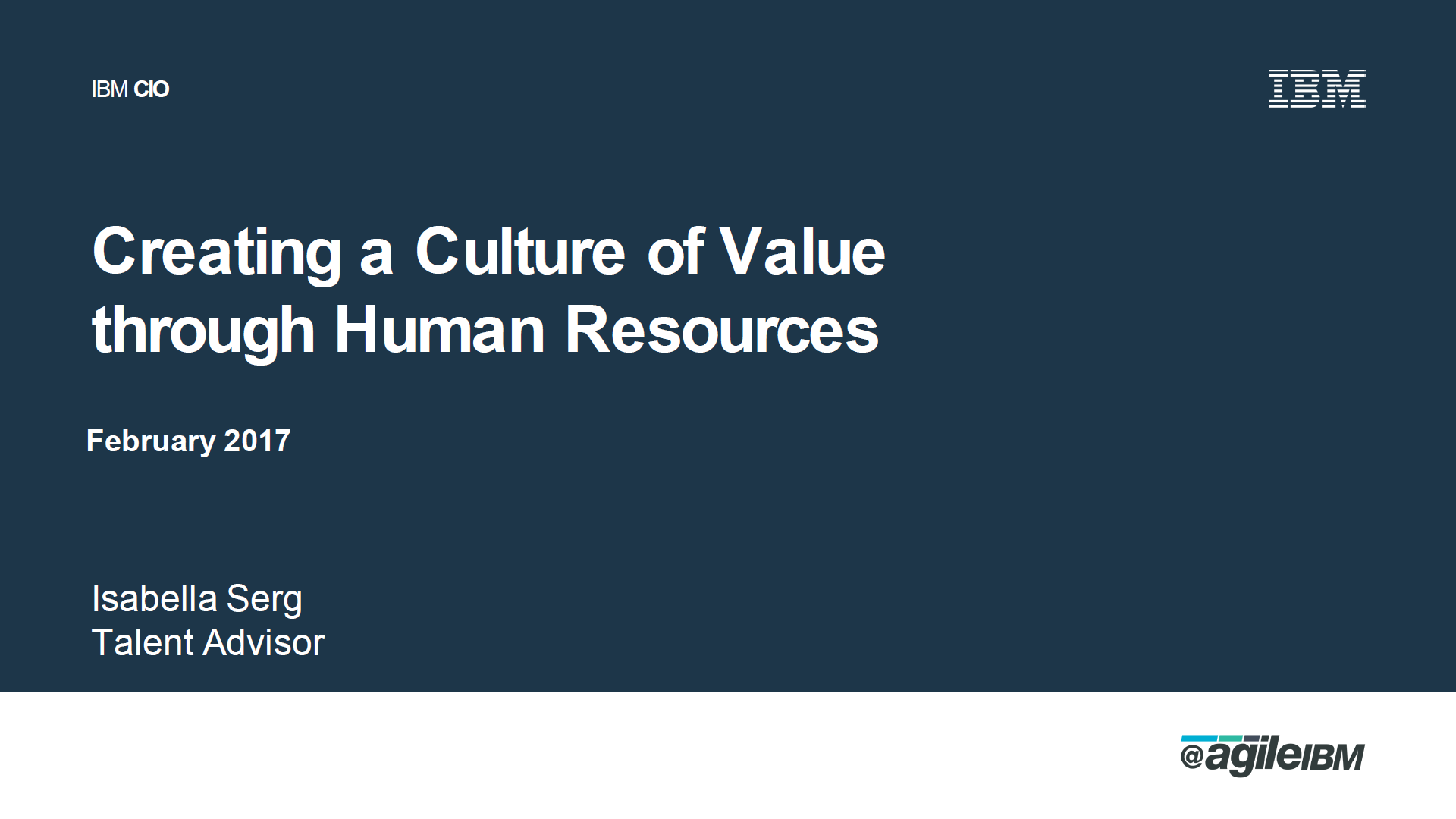Thank you so much for having me today. How are you all feeling after a big lunch session? How much brainpower do we have for the next 18 minutes? Full brain? Hands up! What about maybe half a brain and ready for a nap? No one ever really likes to admit that they have half a brain.
As Christina mentioned, I spent the first part of my formative career in an Agile HR team in Australia, where I learned a lot about Agile. I have since moved to IBM’s Chief Information Office, supporting their Agile transformation, where I am learning even more. Yesterday set a great scene for the why, and today, I want to focus on the how. How can we actually move from command-and-control management environments into Agile environments?
What I’d like to do is reflect on my experience as an Agile HR professional to illustrate how this transition happens. My goal is to share lessons that you can take away on Monday morning when you’re grappling with this change—amidst the other hundred things on your plate. Of course, there are excellent consultants here who will be happy to help with that challenge!
Key Focus Areas
Today, I want to focus on three key topics:
- Some of the challenges I’ve seen in implementing Agile in non-IT teams.
- How these challenges have been addressed—both in my work and by others.
- Key lessons learned that you can take away and apply next week.
Why is HR Ready for Agile?
Yesterday, I had a conversation with Evan Campbell from Solutions IQ, and he mentioned that HR teams seem to be pulling a lot of IT tools and artifacts into their work. He asked, “Why do you think HR is so ready for change?”
Upon reflection, I realized the answer is actually quite simple. As one of the speakers said, “If you really care about your customers, and we all say we do, then you have to care about your people too.” That’s a powerful place to start.
Challenges Driving the Need for Change
There are several key trends and challenges pushing HR towards Agile transformation:
1. The War for Talent
The competition for talent—especially in STEM fields—is intense. I spent part of my career working in internship and graduate hiring programs, and I can tell you firsthand that the next generation of talent wants more than just free food and soda (though they appreciate that too). They are looking for great corporate culture, access to strong leadership, and excellent learning and development opportunities. These factors are shaping their career decisions.
2. The Changing Nature of Work
Does anyone know how many people work at IBM worldwide? It’s around 400,000—and that doesn’t even include contractors. That’s a lot of Christmas parties! But it also presents a huge challenge when it comes to working effectively across different time zones, with remote teams, and in hybrid work environments.
3. Leadership Challenges
We need to better support leaders in managing both high and low performance across organizations. Hand on your heart—if you’re a leader, how much do you enjoy knowing that on Monday morning you have 80 annual performance reviews due by the end of the week? Judging by the laughs, I think a few of you can relate!
If we’re serious about tackling the challenges discussed at this conference, we must improve leadership capability. At IBM, we are benchmarking IT leaders across six Agile practices to bring leaders and squads closer together and enhance feedback loops. Leaders must be able to set expectations, provide feedback, and hold people accountable for their work. That’s our challenge, and we’re starting there—but we still have a long way to go.
My First Experience with Agile in HR
A few years ago, I worked in an Agile HR team at a financial services organization in Australia. For those unfamiliar with HR structures, they often operate like legal or finance teams—supporting business strategy rather than delivering end-to-end client value.
Our team was organized by specialization rather than customer needs, leading to inefficiencies. We had no standardized way to prioritize work. Requests came through email, from executives, or even via desk drop-ins, creating a constant backlog. This resulted in an unsustainable pace of work—some of our initiatives were fantastic, while others completely missed the mark.
To fix this, we decided to eat our own dog food and apply Agile principles to ourselves. We embarked on a transformation journey to improve how we operated and supported our clients.
Our Change Objectives
- Make work visible.
- Develop a single, consistent delivery approach.
- Improve cycle time (we aimed for 10% faster but ended up exceeding that goal).
- Increase employee engagement.
Key Challenges in Agile HR
1. Specialization
HR teams are often highly specialized, leading to a “this is my job, that is yours” mentality. Leaders have little visibility into their teams’ workloads, making it difficult to allocate resources to high-value work.
2. Work in Progress (WIP) Management
One Agile principle is limiting work in progress—“Stop starting, start finishing.” But in HR, work often feels unpredictable, making it difficult to visualize or track. This contributes to over-servicing and inefficiencies.
How We Addressed These Challenges
To overcome these issues, we started with tough questions. Through multiple workshops, we mapped our challenges, identified root causes, and assessed our Agile maturity. Only then did we define our long-term goals.
Key Actions Taken
- We redesigned our teams through a self-selection process.
- We made work visible by maintaining a clear backlog.
- We eliminated annual planning in favor of 12-week iterative cycles.
- We introduced a decision register to document and communicate decisions transparently.
- We measured our progress to track improvements.
Lessons Learned
1. Lipstick Agile Doesn’t Work – Agile has to come from the top, and leadership must be fully invested.
2. Empowerment Requires Accountability – Teams must take ownership of budgets, risks, and work prioritization.
3. Understand Your Talent Mix – Identify skill gaps and either retrain or hire accordingly.
4. Experiment with Collaboration Tools – We adopted tools like Slack to improve communication and reduce unnecessary meetings.
5. Measure What Matters – Track progress to continuously improve.
Final Takeaways
The talent challenges we face require a new approach to leadership, recruitment, and retention. You will encounter naysayers who claim Agile is too difficult or unpredictable—but you must find ways to bring them along on the journey.
In the military, the difference between a failed operation and a successful mission is small unit leadership. The Allies spent years planning for the Battle of Normandy, but on D-Day, success depended on a handful of men executing on the ground. Similarly, your best strategies will only succeed if your teams are equipped and empowered to deliver.
I hope you leave here today with a passion and drive to equip yourselves and others with the tools needed to execute your mission.
Thank You
Thank you.




